Energy Currencies
Energy currencies are the different ways we store energy for use. Understanding the different currencies is crucial to understanding our energy challenges.
Last Updated: May 2012
Charlotte Helston
To properly understand our energy system, the concept of energy carriers, or energy currencies, is essential. It is important to differentiate between energy currencies, like gasoline or electricity, and energy sources, like crude oil or uranium to interpret how the energy we use arrives at our disposal. David Scott, author of Smelling Land: The Hydrogen Defense Against Climate Catastrophe says, "One difference is that currencies are harvested from sources: Gasoline is harvested from crude oil and electricity can be harvested from uranium."
Scott draws an analogy with monetary currencies to illustrate the concept: Gold is to cash, cheques and telecurrencies, as crude is to gasoline, butane, diesel, etc. Types of monetary currencies can include pesos, yen, dollars, and baht. Each monetary currency is appropriate only in certain transactions. You wouldn't use telecurrencies to buy a chocolate bar, or a fleet of moving vans full of pennies to purchase a house. Likewise, you wouldn't use electricity to fly an airplane, or Jet-A to run a computer. Thus, transactions of currencies for both monetary and energy currencies are limited.

Petroleum is a hugely useful energy currency for our modern transport economy, but must still be refined from the primary energy source crude oil before it can be used.
The monetary currencies analogy can also help to explain the concept of energy conversions. Some currencies are easily converted, others are not. For example, it is easy to convert paper bills into bits of plastic called credit cards, but not so convenient to convert that money into, say, gold bricks. Similarly, we can easily convert gasoline into electricity using generators, but the reverse, changing electricity into gasoline is not possible. These one-way currencies, Scott says, "severely restrict our ability to design efficient and, most importantly, robust energy systems."
As we funnel energy currencies down the conversion chain, energy is wasted. But we put up with it because the energy system demands it: We can't "jam nuclear reactors into TV sets," says Scott, we have to convert nuclear energy into electricity. And each step of the way — from converting the heat from nuclear fission to steam energy, to steam driven turbines, to rotating shaft driven generators which creates medium voltage electricity, and so on until the current has passed through several transformers and is ready to power your television — loses energy.
The gateway to solving our energy crisis?
Scott goes on to say that the world's obsession with discovering new energy sources is the wrong way to address our energy problem. We have plentiful sources — solar, wind, geothermal, just to name a few — it's currencies that will ultimately determine the success of a given energy source. The bottom line: It's important to distinguish between the different parts of our energy system, and analyze how they are working both independently and as part of the whole. Looking at our energy system in this way will help to improve the entire energy pathway, from cradle to grave.
Below is a long list of energy currencies used today, from fossil fuels to biofuels, fuel cells to batteries. Remember, every currency has a source that possesses its own set of impacts, as well as a pathway and series of transformations that also generate impacts. Consider the concept known as "cradle to grave" or the vehicle-specific "wells to wheels" when reading over the following currencies. How, and from what, are they derived? How are they converted from source into currency, and currency to currency?
Electricity
Electricity is a secondary energy source, or in other words, an energy currency. This means that electricity is created from the conversion of other sources of energy, like coal and nuclear power plants or wind turbines (primary energy sources). The energy sources used to generate electricity may be renewable (hydroelectric) or non-renewable (natural gas), but electricity itself is neither renewable nor non-renewable.
Electricity is used to power lights, heating and cooling systems, and electronics like televisions and computers. Because you can't see it, it's hard to visualize the resources it consumes. For example, it takes 0.014 lbs of coal to light one fluorescent tube for one hour. If that bulb was left on for a year, a lump of coal the size of large dog (122.64 pounds) would be consumed. It is important to understand that electricity doesn't come from your wall: it comes from a variety of energy sources that can either have a greater or lesser impact on the environment.
Fossil Fuels
Fossil fuels are forms of compacted carbon that are dug out of the ground and used to power our civilization. They provide over 80% of all the primary energy used in the world. Coal and natural gas are primarily used to provide electricity and heating, while oil runs the world's transportation economy.
Fossil fuels form over the course of millions of years. It is commonly thought that fossil fuels were formed from the decayed remains of dinosaurs. But the reality is that ancient forests, algae blooms and plankton provided the vast majority of the carbon for making fossil fuels. Though, undeniably, there were some dinosaurs mixed in too. Depending on what kind of life and the geological conditions, one of the three fossil fuels might form (coal from forests, oil and gas from plankton and algae).
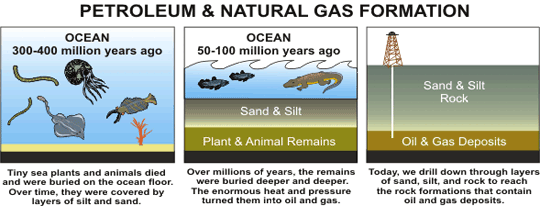
Over millions of years these decayed remains were covered over by thousands more layers of other decomposing remains, and then rock and sand which pressed down on them. Pressure from the rocks above, and the heat from the Earth's core below, cooked the once-living carbon, breaking the bonds that held the molecules together. This led to the formation of huge reserves of oil, coal or gas. This process is extremely slow and incremental, and, like biological evolution, can only be understood when viewed on the timescale of hundreds of millions of years. Most of the carbon we burn in our tailpipes comes from creatures that lived around 360 million years ago, an inconceivably long time scale when compared to a human lifespan, or even the existence of the human species.
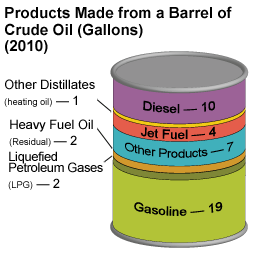
Refining the primary energy source crude oil creates a number of useful energy currencies. Here is what the average barrel of crude oil is converted into in the U.S.
Humans have known since the Roman Empire and Han China that coal, oil and gas can be burned to create heat, and mines were dug and fossil fuels extracted on a small scale even at these early dates. But what was not understood until the 18th and 19th Centuries was that the heat from those other fossil fuels could be used for things other than heating, lighting or cooking. They could be used to move machines. The steam engine developed in England around this time was the first to burn coal, which heated water, creating steam which spun a turbine.
A more comprehensive history of the fossil fuel economy can be found here.
Coal
Coal is still hugely important today for generating electricity, though it is not used for transportation anymore. Coal is an inexpensive and technically simple, if dirty and damaging, way to create the usable energy currency, electricity.
Oil
Oil was the second fossil fuel to become widely utilized in the modern age. Oil is extracted from the ground in a form known as crude oil. Crude oil has many impurities making it useless for most of the energy applications we use today.
It must therefore be refined after it is extracted from the ground. This refining usually means heating the oil. At each temperature a different carbon molecule is separated out from the rest of the oil, each of which have their own specific uses. These range from extremely high-quality aviation gas, to heavy bunker oil used in ships and oil heating tanks, with petroleum and diesel for automobiles in the middle. Therefore these refined forms of oil are each an energy currency, while crude oil is the primary energy source from which it is all derived. Most oil is used in efficient internal combustion engines.
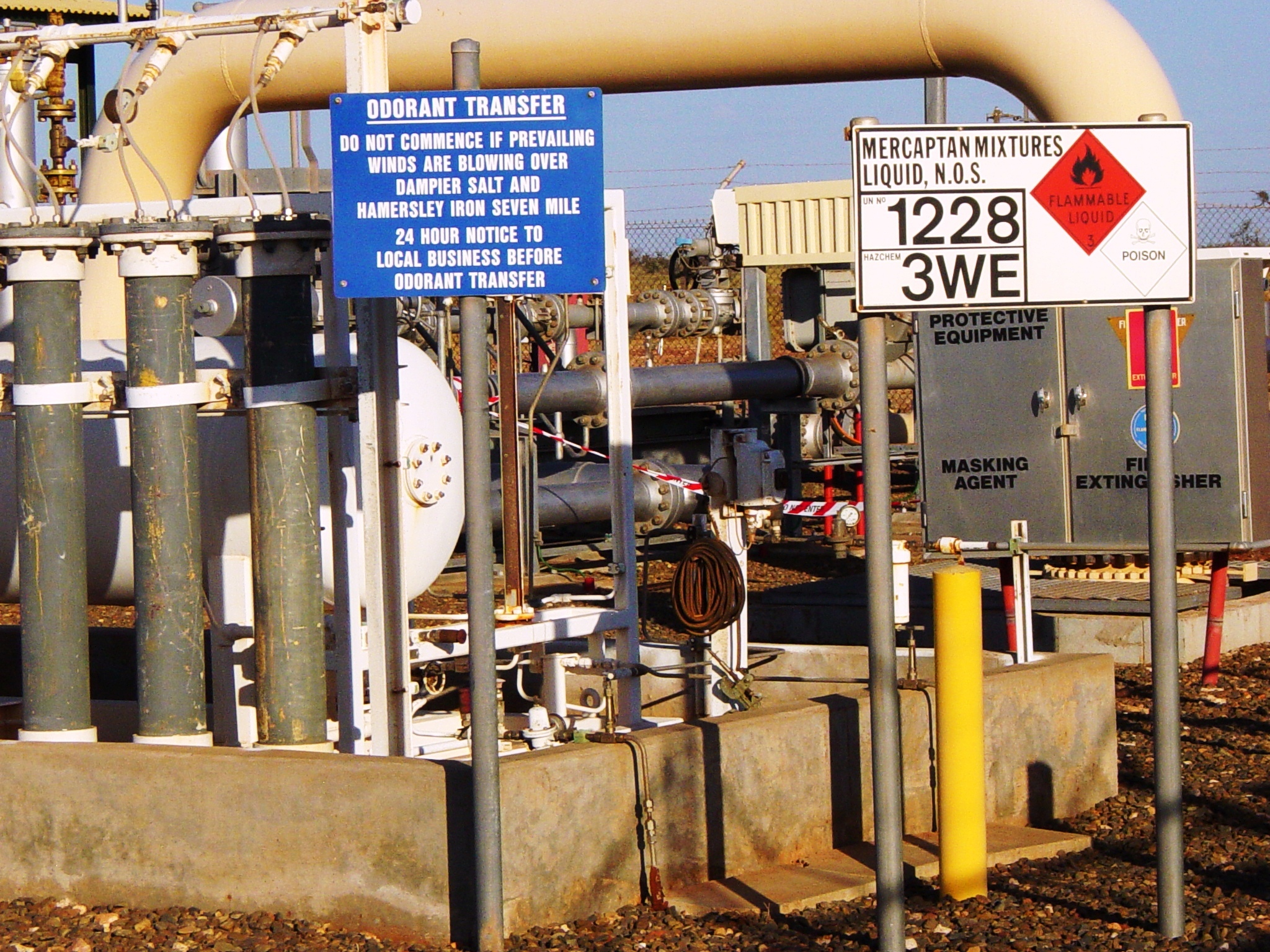
A sign at a natural gas pipeline warning about pipeline odorant.
Oil is so popular as a transportation fuel because it has such a high energy density. You can learn compare the energy densities of various forms of energy at our energy converter here.
Natural Gas
Natural gas became popularized during the course of the 20th Century as the technology to harness the fossil fuel in a gaseous state came into its own. Like oil, natural gas must be refined to remove impurities in order to be usable. It is also injected with an odorant that makes it smell like rotten eggs, to tip off people about a gas leak. Natural gas is today used primarily for electricity generation and heating. Older natural gas plants (such as British Columbia's Burrard Thermal) run on the same steam principle that powers coal plants, but newer plants use turbines that burn gas directly, and even use a combination of steam and turbine technology. As oil prices rise vehicles that run on compressed natural gas (CNG) are also becoming more attractive (which run on the same internal combustion engine as oil).
Biofuels
Where fossil fuels are formed by millions of years-old, decomposed organisms, biofuels are derived from recently living organisms (biomass). Material from plants, animals and organic wastes (the metabolic by-products of animals) is broken down and processed using a variety of technologies, discussed here. The principle biofuels in use today are:
Solid Biomass

Hundreds of millions of people worldwide continue to rely upon solid biomass for all their fuel needs.
Solid biomass includes materials like wood, sawdust, charcoal, agricultural waste, dried manure, and plants from dedicated fuel-crops. Raw biomass such as wood can be burned in a stove or furnace to generate heat for warmth and cooking. Wood and manure fuels remain a principle source of heating in the developing world.
Materials such as sawdust, wood chips and agricultural waste are typically put through a densification process before use. The result is what is commonly referred to as "hogfuel" — compact biomass in the form of pellets, cubes or pucks.
First Generation (First-Gen) Biofuels
First-generation, or conventional biofuels, are derived from plant starches, sugars and oils, as well as animal fats. Commonly, they use materials already in demand as food sources, like corn and soybeans. There are several types of first-gen fuels. Below, they are listed in order of prominence on the global energy scene.
• Bioalcohols:
Produced from fermented sugars and starches (and from cellulose as a second generation biofuel) biologically manufactured alcohols offer the same functions of fossil fuels like gasoline. The difference is we can easily grow first-gen fuels in crops like corn and sugarcane. The most common product is ethanol, and to a lesser extent propanol and butanol. Ethanol can be produced using the sugars contained in wheat, corn, sugarcane, molasses, potatoes — basically anything you could make an alcoholic beverage from. Ethanol is used in a range of concentrations, from E100 (100% ethanol) to E5 (5% ethanol). Blends of E15, E20, and so on are all possible. Ethanol possesses a smaller energy density than gasoline, meaning vehicles require more fuel to deliver the same power. Read more about ethanol in the Biofuels Energy Profile.

Yellow corn, one of the most important sources of biofuels today.
• Biodiesel:
Derived from oils or fats by means of transesterification, biodiesel can be blended with petroleum diesel in any percentage, or used in its pure form (B100 for 100% diesel). B20 (20% biodiesel) is the most common blend and can be used in nearly all diesel equipment. When blends increase above 20%, certain drawbacks tend to occur, such as lower energy content per gallon (8% less energy per gallon than petro-diesel), low-temperature gelling where the fuel's viscosity is too high for use, and microbial contamination. Read more about biodiesel in the biofuels energy profile.
Vegetable oil is an oft-used feedstock for biodiesel, but it can also be used simply as is, in the form known as straight vegetable oil (SVO). Using SVO can have unfavourable long-term effects on engines, and is thus not a choice fuel at this point in time. Some individuals concoct their own SVO by heating up waste oils. There are numerous "how to's" on the web.
• Bioethers:
Bioethers are primarily used as blending components for gasoline. Combined with any fuel, bioethers improve performance and emissions levels due to their high octane and oxygen content. Bioethers are produced by the dehydration of organic substances. The feedstocks for bioethers include ethanol (derived from fermented sugars and starches) and methanol (derived from biomass).
• Biogas:
Biogas is produced when methane rich substances (sewage sludge gas, corn silage, liquid manure, etc...) undergo a process called anaerobic digestion. This process involves microorganisms that break down biodegradable matter into usable methane. Biogas supports a range of applications including: in CHP gas engines (combined heat and power), for use in cooking, space heating, water heating, and as a replacement for compressed natural gas in vehicles. Biologically produced methane also has potential as a sustainable source of hydrogen for use in fuel cell technologies.
• Syngas:
Syngas, the short form for Synthesis gas, is a gas mixture made up of carbon monoxide, carbon dioxide and hydrogen. The name emerges from syngas' use as an intermediate in creating synthetic natural gas. It is produced through the gasification of a carbon-containing fuel to a gaseous product. Syngas can be derived from coal, wherein the coal is first converted to coke, then combusted under high temperatures.
Next generation (next-gen) fuels
Next generation biofuels offer the possibility of using non-food sources as feedstocks for fuels like ethanol and biodiesel. Such materials include: waste biomass, the stalks of wheat, corn stover, wood, and special energy crops like miscanthus and algae. The technology involved in this branch of biofuels is called BtL (Biomass to Liquid). Products under development include: biohydrogen, biomethanol, DMF, Bio-DME, Fischer- Tropsch diesel, biohydrogen diesel, and mixed alcohols. This technology is not yet cost comparative to first generation biofuels.
Hydrogen
How do we obtain pure hydrogen?
Hydrogen, comprised of only one proton and one electron, is rarely found in a natural state. Commonly, it is bonded to other elements, like oxygen, which gives us H2O, or water. It is also found in the hydrocarbons that make up fuels like gasoline, natural gas, methanol and propane. There are a range of methods in use today to produce hydrogen. The predominant technologies are electrolysis, a process that splits hydrogen from water, and extraction from fossil fuels in a heating process called reforming.
Extracting hydrogen from other materials uses energy. If both the source of material and the energy used to split hydrogen from it are clean, hydrogen fuel could indeed make a significant contribution to the greenhouse gas problem. Unfortunately, it is primarily dirty sources of energy that are used to create hydrogen, rendering the clean end product far from environmentally benign.
Presently, the majority of hydrogen is produced by steam reforming natural gas. Though the resulting fuel is clean, the process of obtaining it is not without problems. Natural gas is already a usable fuel, one that is becoming scarcer. Additionally, the reformation process emits carbon dioxide, contributing to the greenhouse effect. Efforts to produce hydrogen from renewable energies (like solar and hydroelectric) are currently underway.
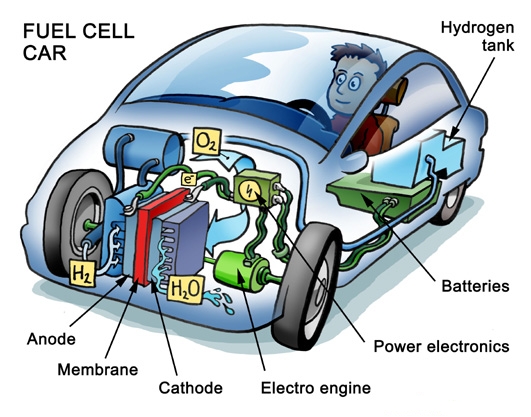
An array of different types of small portable batteries.
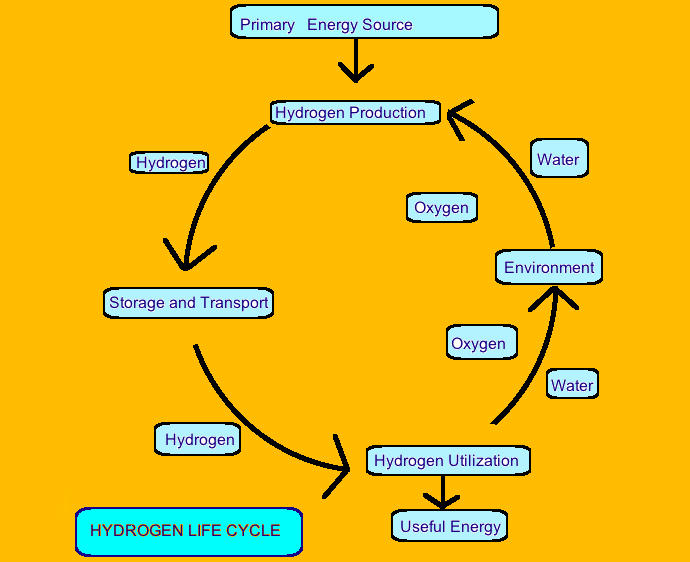
The Hydrogen Life Cycle
Hydrogen Fuel Cells
Fuel cells are what make hydrogen appealing as a fuel for transportation, as well as stored energy for homes and other applications. Fuel cells produce direct-current electricity (and the by-products of heat and water) by combining pure hydrogen with oxygen. Certain properties of fuel cells are similar to batteries, though the technologies are quite different. Fuel cells use external fuel while batteries are charged with already stored electricity. Both use a chemical reaction, rather than combustion, to create power. A key difference is that fuel cells will continue to produce electricity as long as hydrogen is supplied, never losing their charge. Batteries eventually "die" and need to be thrown out or recharged.
Fuel cells use various catalysts (chemicals that trigger chemical reactions without themselves being consumed in the reaction), like platinum, to convert the stored energy to electricity. Catalysts in fuel cells are, at the moment, predominantly expensive metals — a certain barrier to their expanded use. When the reaction is triggered in, for example a Polymer Electrolyte Membrane (PEM) fuel cell, the hydrogen molecules split into protons and electrons. Protons are filtered through a membrane, while the electrons flow through an electrical conductor, creating electricity. This process also generates heat, which can be of use in co-generation plants.
The term "fuel cell" may refer to a single unit, or a stack of cells. Depending on the application, fuel cells can be built of anywhere between one and dozens of individual cells, lending to their diverse uses. Fuel cells can thus be used in an array of applications, including: laptop computers, homes, vehicles, and central power generation systems.
How Can We Use Hydrogen?
The dominant application for hydrogen, at present, is for industrial processes, such as refining, treating metals, and food processing. Hydrogen is either delivered to factories through pipelines in the form of compressed or liquid hydrogen, or is generated on-site by electrolysis or reforming.
As a transport fuel, hydrogen is most notably used in the sky, rather than on the ground. The National Aeronautics and Space Administration (NASA) has been using hydrogen in its space program since the 1970s due to hydrogen's high energy-to-weight ratio. Liquid hydrogen fuel is used to lift space shuttles into the air, while hydrogen fuel cells power the shuttle's electrical systems. The by-product, water, is used for drinking by the crew.
Hydrogen fuel cells create electricity, something humans use a lot of. In theory, anything that uses electricity — refrigerators, lights, heating systems — could be supported by a hydrogen fuel cell. Due to the high cost of manufacturing fuel cells, this wont be a reality for some time, if ever. The same goes for large hydrogen power plants which are possible, but out of the budget for now. In some niche cases, like emergency power systems in hospitals and wilderness locations, fuel cells are currently demonstrating their potential.
And of course, hydrogen fueled vehicles: cars, buses, motorcycles, airplanes — if you can drive it, fly it, ride it, you can probably fuel it with hydrogen.

On the left is Boeing's Fuel Cell Demonstrator, powered by a hydrogen fuel cell. On the right is a Yamaha scooter powered by a fuel cell.
The two main barriers to the commercialization of hydrogen fuel cells are high production costs and poor durability.
Though hydrogen can be used in internal combustion engines, most applications use fuel cells to convert the energy into electricity to power electric motors. If hydrogen was to be used in an internal combustion engine , a massive fuel tank would need to be installed, because though hydrogen supplies more energy per pound than gasoline, it possesses a much lower density in both liquid and compressed gas form. The costs of opting for an electric, hydrogen powered vehicle remain much higher than for a conventional, fossil fueled vehicle. Additionally, what some call the "chicken and egg" dilemma of the hydrogen economy highlights the challenge in selling hydrogen cars before refueling stations become abundant, and the flip side, building refueling stations when there are no hydrogen cars or customers. Integrating the hydrogen fueled vehicle into our present system of energy sources, currencies and infrastructure will prove difficult without government support for the transition.
Why Use Hydrogen Fuel?
The use of fossil fuels in vehicles produces carbon dioxide and water. Blending hydrogen into fossil fuels results in fewer CO2 emissions, and greater quantities of water. The higher the hydrogen content, the cleaner the fuel. Not only are hydrogen fuels cleaner than fossil fuels, they can also have double to triple the efficiency of traditional combustion technologies. The US Department of Energy notes the efficiency of a combustion-based power plant at 33-35%, compared to fuel cell systems that can generate electricity of 60% (more when the heat generated from the reaction is used in cogeneration). It was further noted that gasoline engines in conventional cars are less than 20% efficient at converting the energy in gasoline into power that propels the vehicle. Hydrogen fuel cell vehicles, which use electric motors, use 40-60% of the fuel's energy. Simple math shows that this corresponds to a reduction in fuel consumption of over 50%.

The disaster that befell the German airship Hindenburg in 1937 has helped shape public perceptions of hydrogen power.
Challenges Ahead
The two main barriers to the commercialization of hydrogen fuel cells are high production costs and poor durability. Many of the component pieces of the fuel cell are expensive, and until alternative materials are discovered the monetary cost of the cells will bar expansion in the field.
The membrane component of the fuel cell, the part that protons filter through but electrons do not, remains problematic for its lack of durability. The challenges of developing a membrane that functions in both hot and cool temperatures, and can remain stable under cycling conditions are a main focus for researchers.
As well when talking about the use of hydrogen people often think back to the Hindenburg disaster where an airship went up in flames as the hydrogen gas inside it burned. While the technology exists to make the process safer there is still a social stigma which challenges the implementation of technologies with dangerous properties.
Batteries
Batteries allow us to store energy in a portable format. Without them, everything that uses electricity would have to be plugged in at all times. No cell phones, no portable laptops, no flashlights, no car motors as we know them.
Batteries are comprised of three main parts: an anode (the negative end), a cathode (the positive end) and an electrolyte which facilitates the flow of energy. Batteries are either primary (non-rechargeable) or secondary (rechargeable).
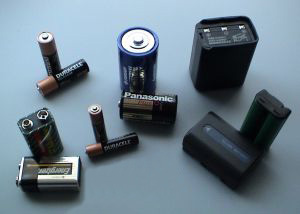
An array of different types of small portable batteries.
Primary and Secondary Batteries
The electrochemical reaction that causes batteries to release energy can be reversed in rechargeable (secondary) batteries. Running current into the cell replenishes its stored energy by running the chemical reaction in reverse. This makes rechargeables suitable for use in automobile starters, portable electronics, electric cars — anything that would be costly to have to replace each time the battery died.
In primary batteries or "disposable batteries", the electrochemical reaction is not reversible, which prevents the cell from recharging. All batteries exhibit a phenomenon called "self-discharge" where internal chemical reactions inside the battery reduce the stored charge and shorten shelf-life. When you use a battery that has been stuck in a drawer for several months, it will likely have less charge than you expect. Primary batteries have significantly lower self-discharge rates, making them useful in applications that require long periods of storage. This good charge retention makes primary batteries appropriate for use in such items as flashlights, smoke detectors, and remote controls.
This is not an exhaustive list of primary battery types, rather a review of some of the most common ones.
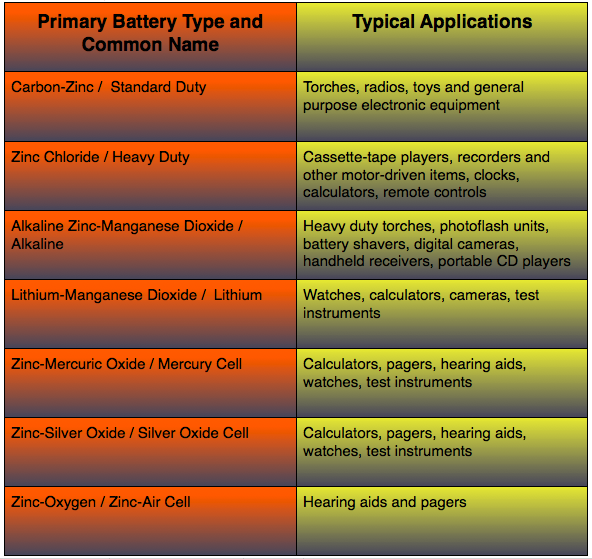
This is not an exhaustive list of secondary battery types, rather a review of some of the most common ones.
Chemical Fuel Cells
Fuel cells convert chemical energy into electric energy. Unlike batteries, fuel cells rely on the addition of an external fuel to function. A reaction between the fuel supply (typically hydrogen, but can be hydrocarbons and alcohols) and an oxidizing agent (usually oxygen, and sometimes chlorine and chlorine dioxide) triggers a reaction that ultimately creates electric current.
Three parts — the anode, the electrolyte and the cathode — are common to all types of fuel cells. The reaction begins at the anode where a catalyst oxidizes the fuel, splitting it into positively charged ions and negatively charged electrons. The electrolyte, also referred to as a membrane, draws the hydrogen ions through it, but not the electrons. The electrons are forced through an external circuit, giving way to electric current that can be used to power an array of applications requiring electricity.
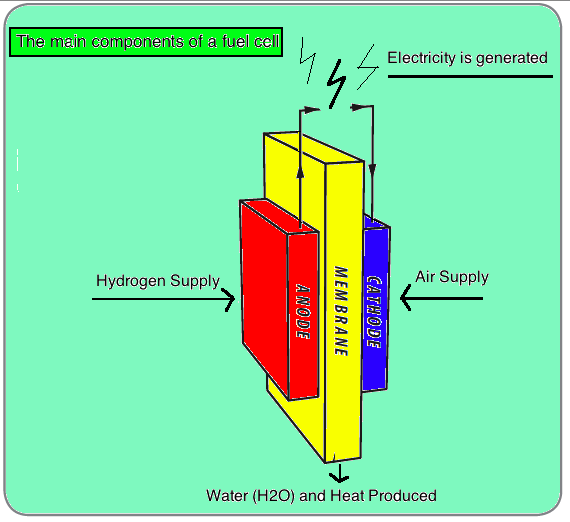
Bibliography
To ensure continuity of material, all of the external web pages referenced here were cached in May 2012.
Readers are recommended to explore the current links for any changes.
"About Hydrogen & About Fuel Cells." Canadian Hydrogen and Fuel Cell Association. 2008. Accessed June 6, 2012.
"B20 and B100: Alternative Fuels." Alternative & Advanced Fuels. US Department of Energy. 2010. Accessed June 6, 2012.
Bringezu, S., H. Schutz, M. O'Brien, L. Kauppi, R. Howarth, J. McNeely. "Assessing Biofuels." United Nations Environment Programme. 2009. Accessed June 6, 2012.
Buchmann, I. "Battery University." 2011. Accessed June 6, 2012.
"Ethanol. Energy Efficiency & Renewable Energy." U.S. Environmental Protection Agency. U.S. Department of Energy. 2011. Accessed June 6, 2012.
"Fuel Cells: Learning About Renewable Energy." National Renewable Energy Laboratory. 2009. Accessed June 6, 2012.
"Hydrogen properties and sources." Hydrogen and Fuel Cell Progress. Government of Canada. 2009. Accessed June 6, 2012.
House, Harold. "Alternative energy sources — biogas production." London Swine Conference — Today's Challenges... Tomorrow's Opportunities. Ontario Ministry of Agriculture, Food, and Rural Affairs. 2007. Accessed June 6, 2012.
"Hydrogen." The NEED Project. Virginia, USA. 2011. Accessed June 6, 2012.
"Hydrogen Explained." Independent Statistics & Analysis - Energy Explained. U.S. Energy Information Administration (EIA). 2011. Accessed June 6, 2012.
"Hydrogen & Fuel Cells." Transportation. Natural Resources Canada- CanmetENERGY. 2011. Accessed June 6, 2012.
"Hydrogen fuel cells." US Department of Energy Hydrogen Program. 2006. Accessed June 6, 2012.
Scott, D.S. "Smelling Land: The Hydrogen Defense Against Climate Catastrophe". Canadian Hydrogen Association. 2007.
Sissine, F. "Renewable Energy: Background and Issues for the 110th Congress." Ch 1. Ethanol and Biofuels Production, Standards and Potential. Ed. W. Leland. Nova Science Publishers. New York.
2009.
When no treaty was signed between the government, and no war was fought over the land, first nations groups in Canada are entitled to the land on which they have historically lived and still inhabit.
In solar thermal energy collectors, the Absorber Area refers to the area absorbing the radiation
A technique where acidic solutions are pumped into a well, melting away debris about the bottom of the well and allowing the gas to flow more freely.
An electrical current that reverses its direction at regularly recurring intervals. Abbreviated to AC.
A series of processes in which microorganisms break down biodegradable material in the absence of oxygen. Used for industrial and/or domestic purposes to manage waste and/or release energy.
A device used for measuring wind speed.
The average speed (and direction) of the wind over the course of a year.
Asia-Pacific Economic Cooperation (APEC): A 21-nation group of Pacific-Rim nations that seeks to promote free trade, raise living standards, education levels and sustainable economic policies. Canada is a member.
The artificially increased discharge of water during the operation of hydroelectric turbines during periods of peak demand.
Small particles released into the atmosphere as part of the flue gases from a coal plant. Fly ash is dangerous for human health but most power plants use electrostatic precipitators to capture it before release.
The waters off the Atlantic provinces that has been producing oil and gas since the 1990s, and continues to have considerable untapped oil and gas potential. The region has similar geology to the oil-rich North Sea.
'The ionizing radiation which we are all inescapably exposed to every day. It comes from radon gas in the ground, the sun, distant supernovas, and even elements inside our own bodies. The average exposure is around 361 mrem per year for a person in Washington state (it varies by region).
Base-load power is that provided continuously, virtually year-round to satisfy a regions minimum electricity needs. Hydro and nuclear power are well-suited for base-load grid needs.
A renewable fuel in which soy or canola oil is refined through a special process and blended with standard diesel oil. Biodiesel does not contain ethanol, but research is underway to develop diesel blends with ethanol.
Renewable energy made available from materials derived from biological sources.
Natural gas, or methane, that is created by microbes consuming organic matter. Usually found near the Earths surface and is usually immediately released into the atmosphere.
Biological material from living, or recently living organisms such as trees, grasses, and agricultural crops. As an energy source, biomass can either be used directly, or converted into other energy products such as biofuel.
A facility that integrates biomass conversion processes and equipment to produce fuels, power, and chemicals from biomass. The biorefinery concept is analogous to petroleum refineries, which produce multiple fuels and products from petroleum.
Bitumen is "petroleum that exists in the semi-solid or solid phase in natural deposits. Bitumen is a thick, sticky form of crude oil, so heavy and viscous (thick) that it will not flow unless heated or diluted with lighter hydrocarbons. At room temperature, it is much like cold molasses."
Bottom Ash: Bottom ash are small particles that result from coal combustion, but unlike fly ash they are too heavy to be released into the atmosphere and must be stored.
Canadian Environmental Protection Act: Passed in 1999, CEPA is "An Act respecting pollution prevention and the protection of the environment and human health in order to contribute to sustainable development."
Cap and Trade: A system where the government sets a limit on how much of a pollutant may be emitted. It then sells the rights to emit that pollutant to companies, known as carbon credits, and allows them to trade the credits with other companies. The EU has implemented a cap and trade program for carbon dioxide.
Carbon Footprint: A calculation based on the set of greenhouse gas (GHG) emissions caused by an organization, event, product, or person.
Carbon Sink: A carbon sink is a natural or artificial reservoir that accumulates and stores carbon-containing chemical compounds for an indefinite period.
Carbon Monoxide: A deadly gas produced from the tailpipe of cars that burn gasoline.
Capacity Factor: The ratio of the actual output of a power plant over a period of time and its potential to output if it had operated at full nameplate capacity the entire time.
Cellulose: An organic compound consisting of several hundred to over ten thousand linked glucose units. Cellulose comprises the structural component of the cell wall in plants, many green algae. It is the most common organic compound on Earth comprising about 33% of plant matter.
Cellulosic Biomass: Fuel produced from wood, grasses, or the non-edible parts of plants that is mainly comprised of cellulose.
Cellulosic Feedstock: The inedible cellulose which comprises most plants and trees. Yields are much higher as any part of the plant can be used and because they do not compete with food, therefore, cellulosic feedstock is an ideal candidate for large scale sustainable biofuel production.
Cetane Rating: Also known as cetane number (CN), this is a measurement of the combustion quality of diesel fuel during compression ignition. It is a significant expression of diesel fuel quality.
Clean Power Call: A request sent out by B.C. Hydro to private power utilities for new electricity-generating projects totalling 5,000 GWh/year. B.C. Hydro will help fund the successful projects and then buy power from them once completed.
How efficiently a turbine converts the energy in wind into electricity. Just divide the electrical power output by the wind energy input.
Using the energy left over from one primary energy conversion to fuel another. The most prominent example of this are natural gas co-generation plants which first feed fuel into a gas turbine. The residual heat from that reaction then heats water to spin a steam turbine.
Collector Area: In solar thermal energy collectors, the Collector Area refers to the area that intercepts the solar radiation.
A mixture of hydrocarbons present in natural gas. When gas is lowered below the hydrocarbon dew point, a condensate, that is, a liquid, forms. These can be used for combustion just like oil and gas. These are also known as natural gas liquids.
Generation of electricity using fossil fuels.
Gas reserves that form beneath porous layers of sandstone. Until recently this has been the only kind of gas commercially extracted.
When bituminous coal is baked at high temperatures it fuses together ash and carbon, creating coke. Coke can then be used to reduce the oxygen content of iron, strengthening it and creating steel.
A force generated by to the earths rotation which deflects a body of fluid or gas moving relative to the earths surface to the right in the northern hemisphere and to the left in the southern hemisphere. It is at its maximum at the poles and zero at the equator.
Decentralized Electricity Generation: Decentralizated electricity generation is a concept used to describe a large number of dispersed energy generators, often closely integrated with the people that use the electricity. Wind turbines and solar panels are good examples: they can be put within communities, be owned by members of the community and generate electricity for it. Alternatively centralized energy generation, far more common in North America, is where a small number of large plants owned by utility companies (hydro-electric, nuclear or fossil fuel) generate large quantities of electricity.
The portion of the oil business that involves refining the crude oil, bringing it to market and selling it. Gasoline service stations are the most lucrative part of downstream operations.
Effluents: Gases or liquids released by a human-made structure, in this case flue gases from a coal-fired power plant.
Electrolyte: Usually a solution of acids, bases, or salts, electrolytes are substances with free ions which make them effective electrical conductors.
Electrolysis: A simple technique for splitting water atoms to obtain hydrogen, driven by an electrical current.
Requirements that set specific limits to the amount of pollutants that can be released into the environment by automobiles and other powered vehicles, as well as emissions generated by industry, power plants, and small equipment.
Transforming one form of energy into another. Most energy conversions that run our economy are conversions from a primary source to electricity (wind or nuclear) or movement (oil).
Energy Currency: Energy that is usable for practical purposes. These include electricity and petroleum which power appliances and vehicles.
A measurement of the amount of energy stored in a given volume.
Energy Return On Investment (EROI): This is the ratio of usable energy obtained over the amount of energy required to get it. The oil sands has a low EROI because instead of being sucked out of the ground in liquid form the oil must be painstakingly mined and heavily refined, a process that requires large quantities of energy itself.
An energy source is the means by which energy is generated. The energy profiles each deal with a different source of energy, and most are simply means to attain the energy currency we all use: electricity.
Enhanced Geothermal System: A new technology, EGS does not require natural convective geothermal resources, but instead can draw power from the ground through extremely dry and impermeable rock.
The provincial Environmental Assessment Office is a politically neutral agency tasked with reviewing major construction projects in B.C. Their purview includes assessing the environmental, economic, social, heritage and health effects over the lifecycle of projects.
A blend of ethanol and diesel fuel. plus other additives, designed to reduce air pollution from heavy equipment, city buses and other vehicles that operate on diesel engines.
A policy device that encourages investment in renewable energies, usually by guaranteeing power producers that their energy will be bought.
In food processing, fermentation is the conversion of carbohydrates to alcohols and carbon dioxide or organic acids using yeasts, bacteria or a combination thereof, under anaerobic conditions. In simple terms, fermentation is the chemical conversion of sugars to ethanol.
A finite, or non-renewable resource, is one where a limited amount exists. Once the existing stocks of that resource are exhausted there will be no more, at least in any reasonable human time scale. Only so much fossil fuels and uranium exist on earth, making these finite, non-renewableresources. The wind, sun and tides are renewable resources since it is impossible to run out of them.
First Generation Renewable: Well established renewable technologies that emerged early on in the Industrial Revolution. These include hydropower, biomass combustion and early geothermal power.
Fission is a nuclear reaction where a heavy atom is hit by a neutron, causing it to split into lighter atoms, release more neutrons, and huge amounts of energy.
Flat-plate collectors are a type of non-concentrating solar energy collector, typically used when temperatures are below 200 degrees F. They are often used for heating buildings.
Flex-Fuel Vehicle: Also known as a dual-fuel vehicle, this is an alternative fuel vehicle with an internal combustion engine designed to run on more than one fuel, usually gasoline blended with either ethanol or methanol fuel.
Flue gases are the gases that are released into the atmosphere by a flue, or pipe, from the steam boiler.
Many biofuel feedstocks such as corn, sugarcane, and soybeans are also key sources of food for millions of people. Production of crops for bioenergy may displace other food-related crops, increasing the cost and decreasing the availability of food. The central question is one of ethics: Should we use our limited land resources to grow biofuels when the same land could be producing food for people?
Fracking: Hydraulic fracturing is the process of injecting high pressure fluids into deep, geologic formations, in order to fracture the rock and render it more permeable.
Fuel Crops: Crops grown specifically for their value as fuel to make biofuels or for their energy content.
Fumaroles: Openings in the Earths crust that emit steam and gases.
Gasohol: Otherwise known as fuel ethanol, gasohol has been distilled and dehydrated to create a high-octane, water free alcohol. All water must be removed because a water-alcohol mixture cannot dissolve in gasoline. Fuel ethanol is made unfit for drinking by adding a small amount of a noxious substance such as gasoline.
Geothermal Gradient: The rate at which temperature increases deeper into the earth, towards the earth's molten core.
Geothermal Task Force Team is a government program that aims to: develop policies, in collaboration with affected agencies, related to tenure issuance, examine the regulation of the use of geothermal resources not currently covered by legislation, build a royalty and resource rent model for geothermal resources, and develop a science based review of the known geothermal resources in the province.
Geyser: Springs characterized by intermittent discharge of water ejected turbulently and accompanied by steam.
Giromill Turbine: Uses lift forces generated by vertical aerofoils to convert wind energy into rotational mechanical energy. They are powered by two or three vertical aerofoils attached to a central mast by horizontal supports.
Glut: A situation where the market has been flooded with goods and there is more supply than there is demand causing the price of goods to drop.
Gravity Survey: A technique of measuring minute changes in the Earths gravity field. This allows geologists to map lighter and denser rocks underground.
Green Energy and Green Economy Act of 2009: Legislation by the province of B.C. to boost the investment in renewable energy projects and increase conservation, create green jobs and economic growth in Ontario. Part of Ontario's plan to become a leading green economy in North America.
Head: The term head refers to the change in elevation of the water.
Head Differential: The difference in pressure due to the difference in height of water level.
Heat Exchangers: These are used in High-Temperature and Low-Temperature applications to transfer heat from one medium to another. In Low-Temperature Geoexchange systems they are built into the heat pump.
Horizontal Axis Wind Turbine (HAWT): Horizontal Axis Wind Turbine. These are the most common types of wind turbines and look like aircraft propellers mounted atop towers.
Hydrocarbons: A compound of almost entirely hydrogen and carbon. This covers oil and natural gas. Coal, the third fossil fuel, contains so many impurities it is usually disqualified from this title.
Hydrostatic Head: The distance a volume of water has to fall in order to generate power.
Intermittent Energy Source:
Any source of energy that is not continuously available due to a factor that is outside of direct control (ex. Wind speed or sunshine).
An internal combustion engine operates by burning its fuel inside the engine, rather than outside of it, as an external, or steam engine does. The most common internal combustion engine type is gasoline powered, followed by diesel, hydrogen, methane, and propane. Engines typically require adaptations (like adjusting the air/fuel ratio) to run on a different kind of fuel than they were designed for. Four-stroke internal combustion engines (each stroke marks a step in the combustion cycle) dominate the automotive and industrial realm today.
Kinetic Energy: The ability of water falling from a dam to do work, that is, to generate electricity. Water stored above a dam has potential energy which turns to kinetic energy once it begins to fall.
Levelized Cost of Electricity: The cost of generating electricity (capital, operation and maintenance costs). Measured in units of currency per unit of electricity (ex. kWh).
Magnetic Survey: A technique for measuring the intensity of magnetic fields from several stations.
Manhattan Project: The massive Anglo-American-Canadian scientific undertaking which produced the atomic bombs that helped end the Second World War. It marked the birth of the nuclear age and scientists were immediately aware of the potential to use use nuclear power for civilian use.
Market Penetration: The share of the total energy market a specific energy source has in relation to its competitors. So the market penetration of wind power would be measured by its share of the electricity market, while ethanol would be compared to other vehicle fuels, not to total primary energy use.
Matrix: In geology, this is the finer mass of tiny sediments in which larger sediments are embedded.
Methanol: Methanol is produced naturally in the anaerobic metabolism of many types of bacteria, and is ubiquitous in the environment. Methanol is toxic in humans if ingested or contacted on the skin. For its toxic properties and close boiling point with ethanol, that it is used as a denaturant for ethanol.
Miscanthus: A low maintenance perennial grass which is thought to be twice as productive as switch grass as it has a longer growing season, greater leaf area, and higher carbon storage per unit of leaf area.
MMBtu: A unit of measurement which means a million Btus (British thermal units). A Btu is roughly the amount of energy it takes to heat a half kilogram of water from 3.8 to 4.4 °C. MBtu is used for a thousand Btus.
Moderator: A moderator is used to slow down neutrons, which enables them to react with the atoms in the nuclear fuel. If enough atoms react then the reactor can sustain a nuclear chain reaction.
M Mount St. Helens is an active volcano located in Washington state. It is most famous for its catastrophic eruption on May 18, 1980 where fifty-seven people were killed, 250 homes, 47 bridges, 24 km of railways, and 298 km of highway were destroyed.
Mud-Pools: Pools of bubbling mud. Also known as "paint-pots" when the slurry of usually grey mud is streaked with red or pink spots from iron compounds.
Nacelle: The housing atop a wind turbine that holds the gearbox, generator, drive train and brakes, as well as the rotors.
Name-Plate Capacity: The intended full-load sustained output of a power plant. For example an average wind turbine's name-plate capacity is 2 Megawatts. The capacity factor is the actual output, so for that 2 MW wind turbine with an efficiency of around 30-35% (average) then it has a more realistic capacity of around 0.7 MW. Most power stations are listed in terms of their nameplate capacity.
National Energy Board: A regulatory agency established by the federal government in 1959 that is primarily tasked with regulating oil and gas pipelines that cross provincial and national borders.
National Energy Program: A set of policies enacted in 1980 that sought to make Canada energy independent. Petro-Canada was created and oil prices were kept artificially low to protect consumers. Shares of oil revenue were diverted to the federal government who used them mostly in the eastern provinces to offset a decline in manufacturing. The program was extremely unpopular in western Canada and was discontinued shortly thereafter.
Nuclear Renaissance: A term used by politicians and the media for the renewed interest in nuclear energy in the past decade. Many countries are now expanding their civilian nuclear programs.
Octane:
The octane rating of a fuel is indicated on the pump – using numbers such as 87, 90, 91 etc. The higher the number, the greater the octane rating of the gasoline.
Oil in Place: The total hydrocarbon (oil and gas) content of a reservoir. Sometimes called STOOIP or Stock Tank Original Oil In Place.
Oil Patch: A term for the Canadian oil industry. This specifically means the upstream operations that find and extract oil and gas, mostly in Alberta but also B.C., the other prairie provinces, Newfoundland and Labrador.
Oil Window: The range of temperature at which oil forms. Below a certain temperature and kerogen will never progress to the form of oil. Too high and natural gas is formed instead.
OECD: The Organization for Economic Co-operation and Development is a 34 country organization dedicated to advocating democracy and the market economy. Membership is largely limited to Western Europe, North America, Australia and Japan, what are often considered the world's developed nations. Sometimes referred to in the media as the "rich countries' club".
Passive Seismic Survey: A way to detect oil and gas by measuring the Earths natural low frequency movements.
Peak Power Demand: Power demand varies over minutes, hours, days and months. Peak power demand are the times when the most people are using the most power. To meet this demand extra sources of power must be switched on. Some forms of electricity generation, such as natural gas turbines, can be turned on quickly to meet peak power demand and are better suited for this purpose than others, such as nuclear, which are better as sources of baseload power.
Permeability: A measure of the ability of a porous rock to allow fluids to pass through it. High permeability in the surrounding rocks is needed for the formation of gas reserves.
Photovoltaic Cell: A non-mechanical device typically fabricated from silicon alloys that generates electricity from direct sunlight.
Pickens Plan: Investment of $1 trillion into wind power in the U.S.A., named for an American oil tycoon. The plan aims to reduce the amount of foreign oil imported to the U.S.A. while providing economic and environmental benefits.
Pondage: The main difference between small and large hydro projects is the existence of stored power in the form of water which is held back by dams at large hydro stations. Some small hydro projects have pondage, however, which are small ponds behind the weir of a dam which can store water for up to a week.
Potential Energy: The energy stored in a body or a system.
Porosity: Closely related to permeability, this is a measure of the amount of "voids," or empty space in a rock where gas or oil can pass through to collect in a reservoir.
Possible Reserves: Possible reserves are a class of unproven reserves that geologists use for oil that they are only 10% sure is present in the ground.
Purchasing Power Agreement: A contract between two parties, one who generates power for sale, and another who is looking to purchase it. B.C. Hydro buys power from companies that build their own power generating stations.
Primary Battery: A primary battery is one that is non-rechargable because the electrochemical reaction goes only one way. It gives out energy and cannot be reversed.
Primary Gas: The degeneration of decayed organic matter directly into gas through a process called "thermal cracking." This is opposed to secondary gas which is formed from decayed oil that has already formed.
Probable Reserves: Probable reserves are a class of unproven reserves that geologists use for oil or gas that they are at least 50% sure is actually present.
Proven Reserves: An amount of a resource any resource to be dug out of the ground (oil, coal, natural gas or uranium in energy terms) that geologists have a 90% or higher certainty can be extracted for a commercial gain with the technology available at the time."
Recompleted: The process, by which an old oil well is redrilled, fractured, or has some other technology applied to improve the amount of oil recovered.
Reforming: In oil refining, reforming is using heat to break down, or crack, hydrocarbon atoms and increase their octane level. This technique creates some left-over hydrogen which can be collected and used.
Renewable Portfolio Standard (RPS):
Law that requires electric utilities to produce some portion of their power from renewable sources like wind, solar, geothermal or biomass. RPSs are necessary to keep renewables competitive in an era of cheap natural gas electricity.
Rent-Seeking: The practice of using resources to compete for existing wealth rather than to create new wealth, often to the detriment of those who seek to reform societies or institutions. Economies that fail to diversify away from oil are often pre-dominated by a rent-seeking mind-set where people become more pre-occupied with securing the windfall resouce profits for themselves, usually oil, rather than seeking to develop new industries.
Reserves: The fraction of the oil in place that can be considered extractable. This depends not only on the geology, but the economics (is oil expensive enough to make extracting it profitable?) and technology.
Reserve Growth: When an oil or gas field is first discovered, reserve estimates tend to be low. The estimates of the size of the field are expected to grow over time and this is called reserves growth.
Ring of Fire: The Pacific Ring of Fire is a region of high volcanic and seismic activity that surrounds the majority of the Pacific Ocean. This region is essentially a horseshoe of geologic activity, characterized by volcanoes, earthquakes, deep sea trenches, and major fault zones.
Riparian: The term riparian refers to the wetland area surrounding rivers or streams. A riparian ecosystem refers to the biological community supported by an area around a river.
Savonius Turbine: Uses drag generated by the wind hitting the cup, like aerofoils, to create rotation.
Second Generation Wind Turbine: Technology that is only now beginning to enter the market as a result of research, development and demonstration. These are: solar, wind, tidal, advanced geothermal and modern bioenergy. Much hope has been placed upon these technologies but they still provide only a fraction of our energy.
Secondary Battery: Rechargable batteries are sometimes known as secondary batteries because their electro-chemical reactions can be reversed.
Secondary Gas: When oil is subjected to so much heat and pressure it degenerates into gas. The process through which this happens called "thermal cracking."
Secondary Recovery Schemes:
When so much oil has been sucked out of an oil reservoir it will lose pressure and the oil will no longer flow out of the reservoir from natural pressure. When this happens secondary recovery schemes can be employed. This means that fluids or gases are pumped into the well to increase pressure and push the remaining oil up out of the well.
Shale: A type of sedimentary rock with low permeability, which was once thought to prevent any commercial extraction of the gas inside. Fracking allows gas developers to access it.
Sound Navigation and Ranging (SONAR):
Initially devised as a technique for detecting submarines. An emitter sends off pulses of sound. The pulses bounce off objects and return to a receiver which interprets their size and distance.
Spot Market: A market where commodities are traded for immediate delivery. A future market on the other hand is one where delivery is expected later on. Because of the dependence of gas users on those who are at the other end of the gas pipeline, the natural gas market is mostly a futures market.
Steam Coal: Steam coal is coal used for power generation in thermal power plants. This is typically coal that ranges in quality from sub-bituminous to bituminous.
Straight Vegetable Oil (SVO): Vegetable oil fuel. Most diesel engine vehicles can run on it so long as the viscosity of the oil is lowered enough for complete combustion. Failure to do this can damage the engine. SVO is also known as pure plant oil or PPO.
Strategic Petroleum Reserve: An emergency store of oil maintained by some governments and corporations. The U.S. Department of Energy holds 727 million barrels of oil.
Subcritical Power Plant: A coal-fired power plant that operates at less than 550ËšC. Because the temperatures and pressures are than other plants, these plants operate at a low efficiency, around 33-35%. These plants are still the most common in the world and many are under construction
Supercritical Power Plant: Supercritical plants are coal powered power plants that can sustain temperatures of 550ËšC to 590ËšC and transfer up to 40% of the coals energy into power. This technology has only come into use in recent years. Most new coal-fired power plants built in the West are supercritical.
Switchgrass:
One of the dominant native species of the North American prairies, tallgrass is being researched as a renewable bioenergy crop. It is a a native perennial warm season grass with the ability to produce moderate to high yields on marginal farmlands.
Thermal Power Plant: A thermal power plant is any that is powered by a steam turbine. The steam is created by heating water which in turn spins the turbine. Most coal and gas power stations operate in this way, as do all nuclear plants. Coal powered and gas plants are often just called thermal plants.
Total Carbon Cost: The amount of carbon dioxide emitted during an action or a process. One exmaple is building a natural gas plant. The total carbon cost would include everything from the carbon emitted to get the materials to build the plant, to the carbon emitted in the building of the plant, and the carbon emitted during the operation of the plant.
Unconventional Gas: Unconventional gas reserves come in many different geological formations, and include tight gas, shale gas, coalbed methane and methane hydrates. Extraction of these sources has only just begun and has hugely extended the lives of many gas fields and unlocking many new ones. The unlocking of unconventional gas reserves in the last five years has revolutionized the global energy system.
Ultracritical Power Plant:
These are coal thermal power plants that operate above 590ËšC and can attain efficiencies above 40%. These plants are just coming into service.
Undiscovered Reserves: The amount of oil and gas estimated to exist in unexplored areas. Much of B.C. has not been thoroughly explored for fossil fuel potential and many of the estimates of B.C. fossil fuel resources rely on the concept of undiscovered resources
United States Geological Survey (USGS): The United States Geological Survey. The department responsible for estimating American fossil fuel reserves. They also conduct many studies that span the globe.
Unproven Reserves: Oil reserves in the ground that petroleum geologists are less certain are there, but have strong reason to believe is present. Unproven reserves can be broken down into probable reserves and possible reserves. These numbers are used within oil companies but not usually published.
The portion of the oil business that involves finding oil and extracting it.
Uranium is a heavy metal that is naturally radioactive. An isotope, U-235 can be enriched to support a nuclear chain reaction. Uranium is used in many nuclear power plants.
A 2,730 MW dam built in north-eastern British Columbia along the Peace River during the 1960s.
Any activity where humans bore down into the Earth to access reserves of oil or gas trapped in underground geological formations.
These are produced from wood residue (like sawdust) collected from sawmills and wood product manufacturers. Heat and pressure are used to transform wood residue into pellets without chemical additives, binders or glue. The pellets can be used in stoves and boilers.
A remote mountain in Western Nevada where the U.S. Department of Energy has planned on storing all of the country's spent nuclear fuel underground since the 1990s. The proposal met stiff opposition from local residents and in 2009 the project was cancelled.












